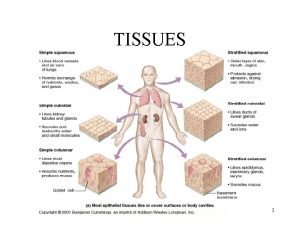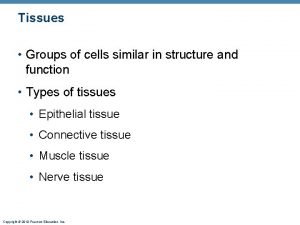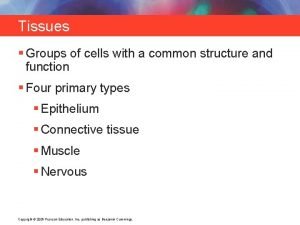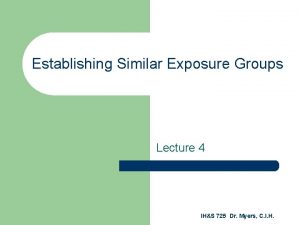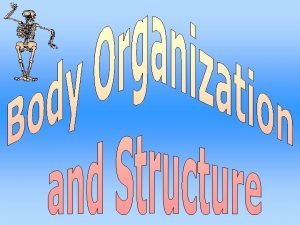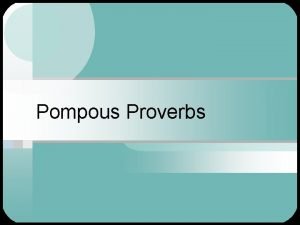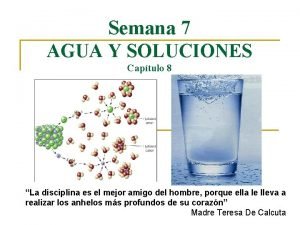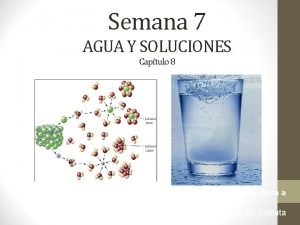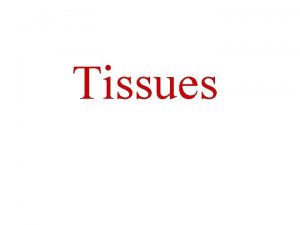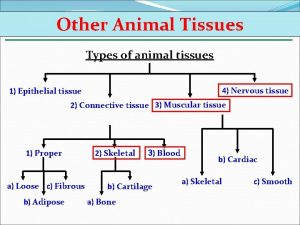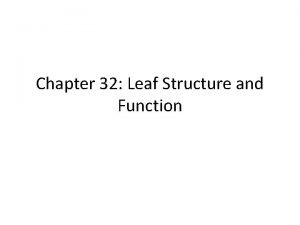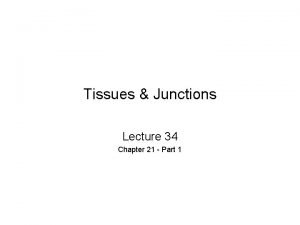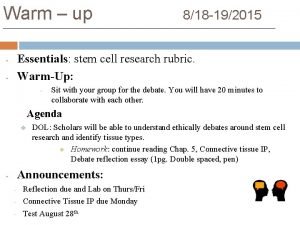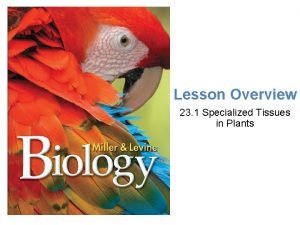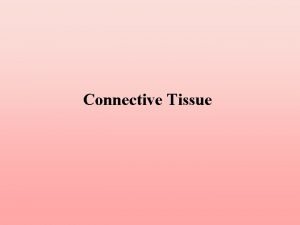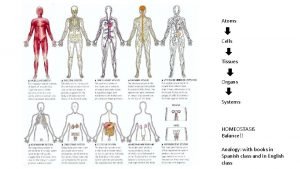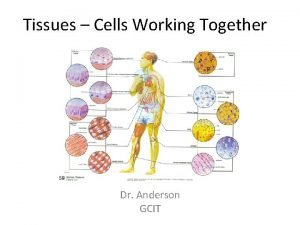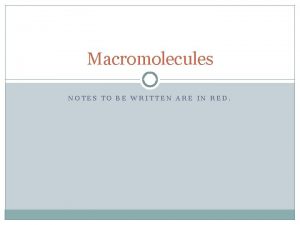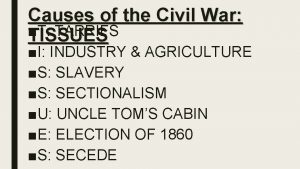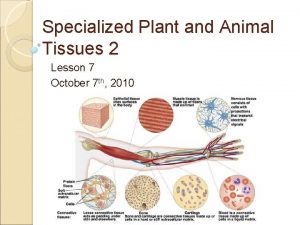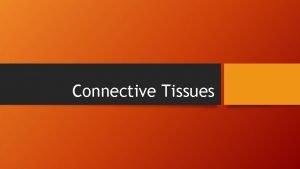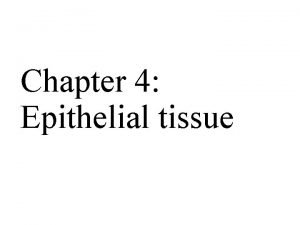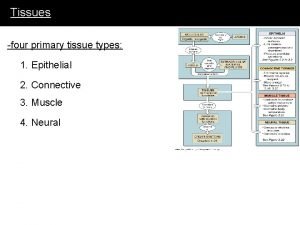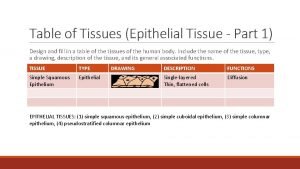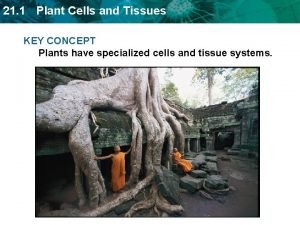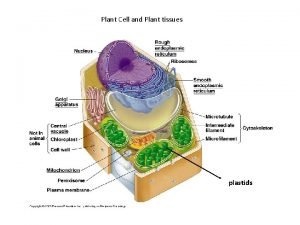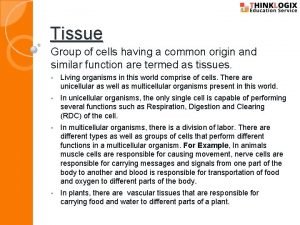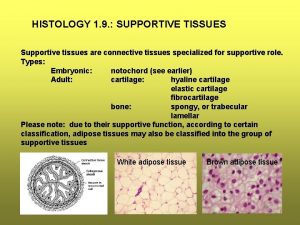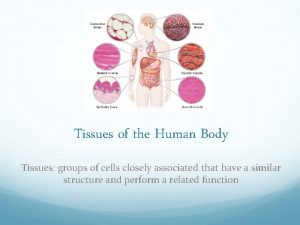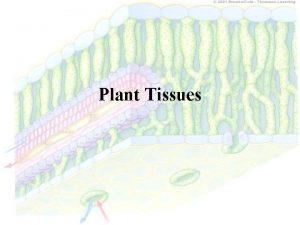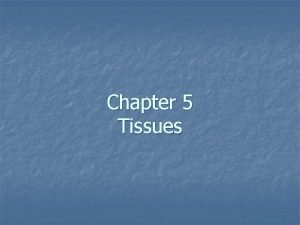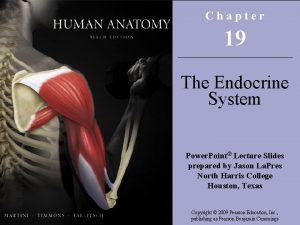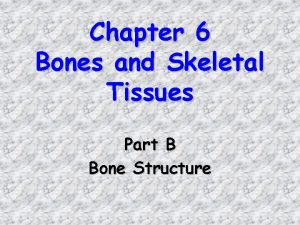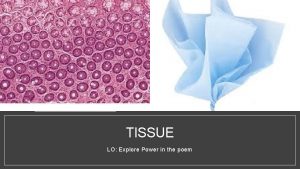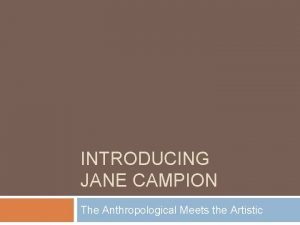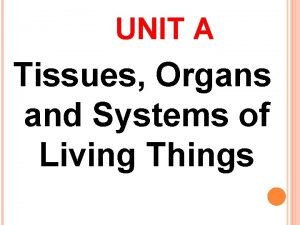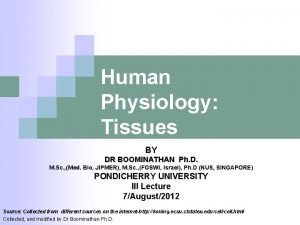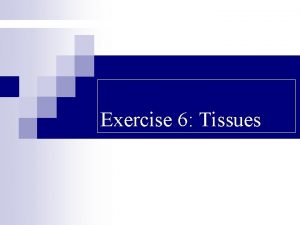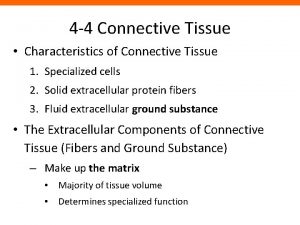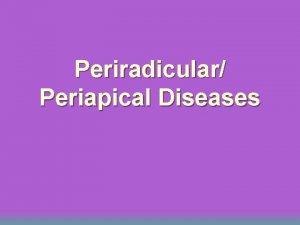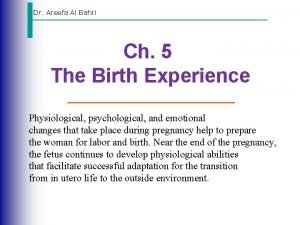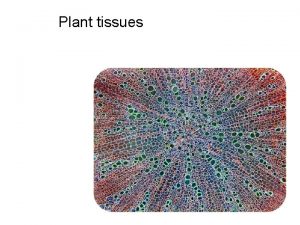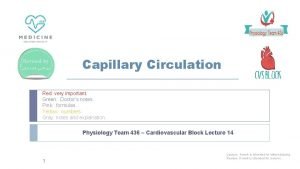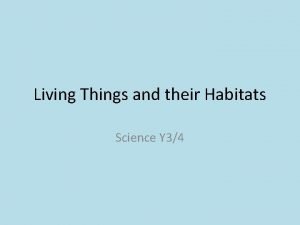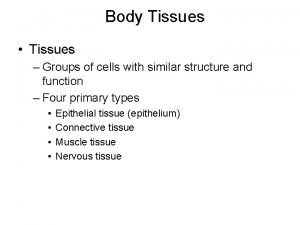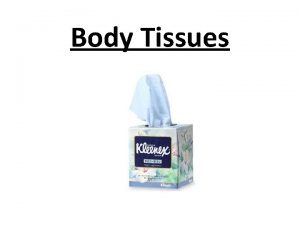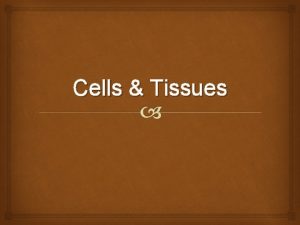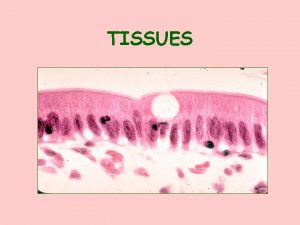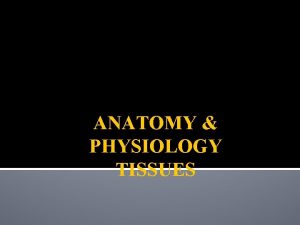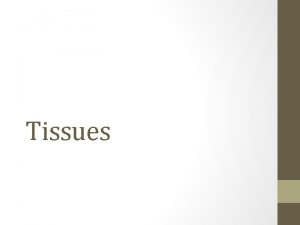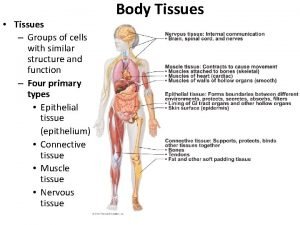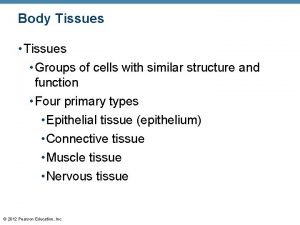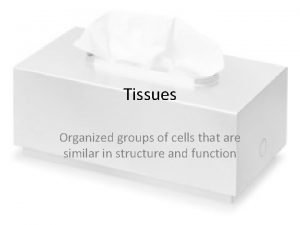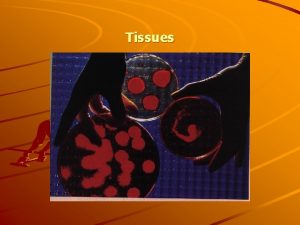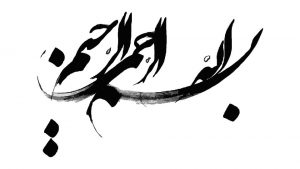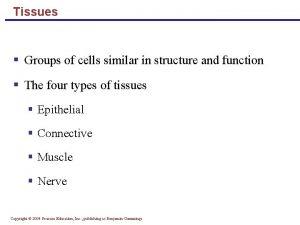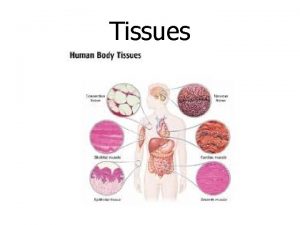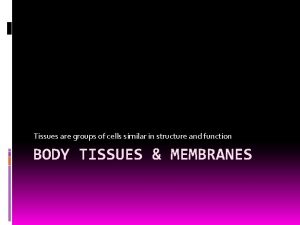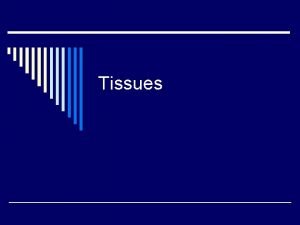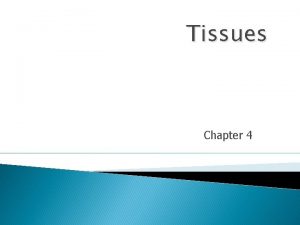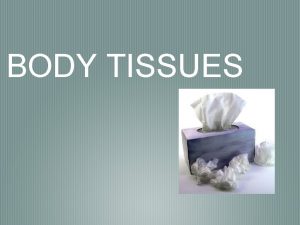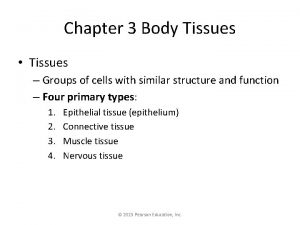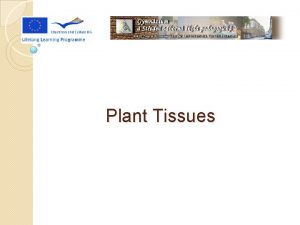Tissues 8 Tissues groups of similar cells that






























































































- Slides: 94

Tissues

8. Tissues - groups of similar cells that perform similar functions 9. Histology - the study of tissues

Four Types of Tissues

11. Epithelial Tissue – covers the body and organs

Epithelial Characteristics a. Cells fit close together b. Usually avascular (no blood supply) c. High regeneration rate d. Attach to a basement membrane

Classification Number of layers Shape

Number of layers • Simple – one layer • Stratified – two or more layers

Simple or Stratified?

Simple or Stratified?

Shape • Squamous – flattened, scale-like • Cuboidal – box-like • Columnar – tall, column-like Nucleus conforms to the shape of the cell

Squamous, Cuboidal, or Columnar?

Squamous, Cuboidal, or Columnar?

Squamous, Cuboidal, or Columnar?

Simple Epithelial C. Absorption, secretion, filtration – not protection

a. Simple Squamous Epithelium – diffuse and filter • Found –air sacs in lungs, blood capillaries

b. Simple Cuboidal Epithelium – secrete and absorb • Found –kidney tubules, ovaries, ducts of glands

c. Simple Columnar Epithelium – absorb and secrete mucus – some are ciliated • Found – lines stomach and intestines

d. Pseudostratified Columnar Epithelium – secrete mucus – nuclei are uneven so looks like many layers • Found – lines trachea

Draw picture in your notes

Stratified Epithelial D. mostly protection – can be more than one shape but is named from top layer

a. Stratified Squamous Epithelium – protect areas from wear and tear • Found – skin, esophagus, mouth

b. Stratified Cuboidal Epithelium – rare • Found – sweat and mammary glands

c. Stratified Columnar Epithelium – rare • Found – male urethra, pharynx

d. Transitional Epithelium – stretchy, easily expands and contracts • Found – bladder, urinary track


What type of tissue?

What type of tissue?

What type of tissue?

What type of tissue?

What type of tissue?

What type of tissue?

What type of tissue?

What type of tissue?

Now with real slides

What type of tissue?

What type of tissue?

What type of tissue?

What type of tissue?

What type of tissue?

What type of tissue?

What type of tissue?

What type of tissue?

What type of tissue?

Four Types of Tissues

12. Connective tissue - joins or connects body structures together, supports, protects, insulates, and transports

Connective Characteristics a. Most abundant tissue b. regenerates at varying rates c. made of mostly nonliving extracellular matrix d. relatively few cells and widely separated from each other

Classification Areolar Fibrous Adipose Cartilage Osseous (bone) Blood

C. Areolar tissue – loose, space filling tissue, supports organs and skin, holds and conveys tissue fluids a. Found – surrounds organs and capillaries

D. Fibrous tissue – dense, attaches muscles to bones or muscles, attaches bone to bone, withstands tension a. Found – tendons and most ligaments

E. Adipose tissue – stores energy (fat), insulates, supports & protects organs a. Found – under skin, around kidneys and heart, abdomen and hips

Nucleus Giant vacuole of fat

Cartilage • Tough but flexible • No nerves or veins • Slow regeneration Hyaline Elastic Fibrocartilage

b. Hyaline Cartilage – most common type, resists compressive stress, supports and reinforces • Found – ends of long bones, ribs, nose, trachea, and larynx

c. Elastic Cartilage – more flexibility but still maintains shape Elastic fibers • Found – ear, epiglottis

d. Fibrocartilage – thick fibers, absorb compressive shock • Found – vertebrae, knee joint

G. Osseous tissue – hardest connective tissue, supports, protects, highly vascular, stores minerals • Found – bones

H. Blood tissue – fluid, transports nutrients and wastes • Found – inside blood vessels

What type of tissue?

What type of tissue?

What type of tissue?

What type of tissue?

What type of tissue?

What type of tissue?

Four Types of Tissues

13. Muscle tissue - contracts to allow body movement

Muscle Characteristics a. Very vascular b. Large amounts of energy c. Lots of mitochondria d. Cells are usually long and slender

Classification Skeletal Smooth Cardiac

Skeletal muscle – move your skeleton a. Voluntary muscle – we consciously control them b. Striated – has narrow bands c. Each cell has many nuclei

Skeletal Muscle

D. Smooth muscle – found in internal organs a. Involuntary muscle – don’t consciously control them b. Not striated – no narrow bands c. Each cell only has one nucleus

Smooth Muscle

E. Cardiac Muscle – found only in the heart a. Involuntary muscle b. Striated and branched 7. Each cell has only one nucleus

Cardiac Muscle Intercalated disks help send nerve signals across a constantly beating heart

Muscle Tissue

What type of tissue?

What type of tissue?

What type of tissue?

What type of tissue?

What type of tissue?

What type of tissue?

14. Nervous tissue - carries information throughout the body

Characteristics a. Neurons - branching nerve cells b. Found – brain, spinal cord, and nerves throughout body c. Almost no regeneration

Structure

15. Tissue Repair A. Inflammation – injured cells release chemicals, blood vessels dilate, clot forms, scab Leads to… Regeneration or Fibrosis

Tissue Repair a. Regeneration - replacing destroyed tissue with the same kind of tissue

Tissue Repair b. Fibrosis - replace damaged tissue with fibrous connective tissue (scar)


Regeneration depends on tissue type Cartilage Skeletal muscle Skin Bone Nervous Tissue Fibrous tissue Cardiac muscle Smooth muscle Blood

What tissue regenerates well? a. Regenerates Well: skin, bone, stomach, blood b. Regenerates Poorly: cartilage, fibrous tissue, skeletal muscle c. No regeneration: nervous, cardiac

Conditions affecting Repair a. Blood supply-needs oxygen and nutrients b. Age- heal faster when you’re younger c. Nutrition-needed vitamins and minerals Vitamins: A=healthy skin C=immune system D=bone E=healing K=blood clotting

16. Issues with Tissues A. Cancer – abnormal growth of cells a. Benign (kindly) – grow slowly, push around cells, localized b. Malignant (bad) – grow quickly, invade other cells, and travel

Carcinogens (cancer causers) include: radiation trauma certain viral infections chemicals (tobacco tars) Cancer can arise from any tissue, but the most common are found in skin, lungs, colon, breast, and prostate Treatments: cut, burn, poison

Colon Polyp

Oral cancer
 Tissues are groups of similar cells working together to
Tissues are groups of similar cells working together to Tissues are groups of similar cells working together to
Tissues are groups of similar cells working together to Tissues are groups of similar cells working together to:
Tissues are groups of similar cells working together to: Body tissue
Body tissue Anatomy chapter 3 cells and tissues
Anatomy chapter 3 cells and tissues 4 body tissues
4 body tissues Body tissues chapter 3 cells and tissues
Body tissues chapter 3 cells and tissues Cells form tissues. tissues form __________.
Cells form tissues. tissues form __________. Groups of cells that are similar in structure and function
Groups of cells that are similar in structure and function Chapter 3 cells and tissues
Chapter 3 cells and tissues Chapter 3 cells and tissues figure 3-7
Chapter 3 cells and tissues figure 3-7 What is the function of the golgi apparatus
What is the function of the golgi apparatus Where are loins on a human
Where are loins on a human Sau thất bại ở hồ điển triệt
Sau thất bại ở hồ điển triệt Thơ thất ngôn tứ tuyệt đường luật
Thơ thất ngôn tứ tuyệt đường luật Block nhĩ thất độ 1
Block nhĩ thất độ 1 Con hãy đưa tay khi thấy người vấp ngã
Con hãy đưa tay khi thấy người vấp ngã Thơ thất ngôn tứ tuyệt đường luật
Thơ thất ngôn tứ tuyệt đường luật Tôn thất thuyết là ai
Tôn thất thuyết là ai Chiến lược kinh doanh quốc tế của walmart
Chiến lược kinh doanh quốc tế của walmart Gây tê cơ vuông thắt lưng
Gây tê cơ vuông thắt lưng Phân độ lown
Phân độ lown Tìm độ lớn thật của tam giác abc
Tìm độ lớn thật của tam giác abc How are ethnic groups and religious groups related
How are ethnic groups and religious groups related Groups of cells with a common structure and function.
Groups of cells with a common structure and function. Similar exposure group
Similar exposure group Somatic cells vs gametes
Somatic cells vs gametes Prokaryotic vs eukaryotic cells
Prokaryotic vs eukaryotic cells Masses of cells form and steal nutrients from healthy cells
Masses of cells form and steal nutrients from healthy cells Paranasal sinuses development
Paranasal sinuses development Nondisjunction in meiosis
Nondisjunction in meiosis What is an organelle
What is an organelle Label
Label Why dna is more stable than rna
Why dna is more stable than rna Tubular lumen
Tubular lumen Cells and life lesson 1 answer key
Cells and life lesson 1 answer key Prokaryotes vs eukaryotes venn diagram
Prokaryotes vs eukaryotes venn diagram Cuál es la diferencia entre la célula animal y vegetal
Cuál es la diferencia entre la célula animal y vegetal Red blood cells and white blood cells difference
Red blood cells and white blood cells difference Parafollicular
Parafollicular Cell organelle jeopardy
Cell organelle jeopardy Prokaryotic cells
Prokaryotic cells A group of similar cells working together
A group of similar cells working together Paraphrasing proverbs
Paraphrasing proverbs Similar disuelve a similar
Similar disuelve a similar Propiedades fisicoquímicas del agua
Propiedades fisicoquímicas del agua Similar disuelve a similar
Similar disuelve a similar What are the four major tissue types
What are the four major tissue types Types of tissues
Types of tissues Leaf structure
Leaf structure What are tissues
What are tissues Layers of epithelial tissue
Layers of epithelial tissue Who classification of periradicular diseases
Who classification of periradicular diseases Specific tissue
Specific tissue Types of tissues
Types of tissues Genetic effects on gene expression across human tissues
Genetic effects on gene expression across human tissues Tissues in plants
Tissues in plants Four basic tissues
Four basic tissues 3 tissues of a plant
3 tissues of a plant Analogy of tissues
Analogy of tissues Tissues working together
Tissues working together What macromolecule is a prominent part of animal tissues
What macromolecule is a prominent part of animal tissues Tissues causes of civil war
Tissues causes of civil war Specialized connective tissue
Specialized connective tissue Tissues
Tissues What do all connective tissues have in common
What do all connective tissues have in common Tissue type
Tissue type Adipose loose connective tissue function
Adipose loose connective tissue function Tissue
Tissue Daun
Daun Tissue design for table
Tissue design for table Cell tissue organ organ system organism
Cell tissue organ organ system organism Plant tissues
Plant tissues Plastid in plant cell
Plastid in plant cell Tissue is a group of cells having
Tissue is a group of cells having What are supportive tissues
What are supportive tissues Supportive connective tissue
Supportive connective tissue Types of tissues
Types of tissues Monocot node
Monocot node Four principal types of tissue
Four principal types of tissue Endocrine tissues
Endocrine tissues Chapter 6 bones and skeletal tissues
Chapter 6 bones and skeletal tissues Tissue structure poem
Tissue structure poem Hannah campion
Hannah campion A tissues
A tissues The circulatory system includes
The circulatory system includes Goblet cells cilia and microvilli
Goblet cells cilia and microvilli Exercise 6 tissues
Exercise 6 tissues Connective tissue function
Connective tissue function Periradicular tissues are
Periradicular tissues are Fetal station
Fetal station Primary meristem
Primary meristem Capillary
Capillary Examples of cultural groups
Examples of cultural groups Vertebrates and invertebrates
Vertebrates and invertebrates

